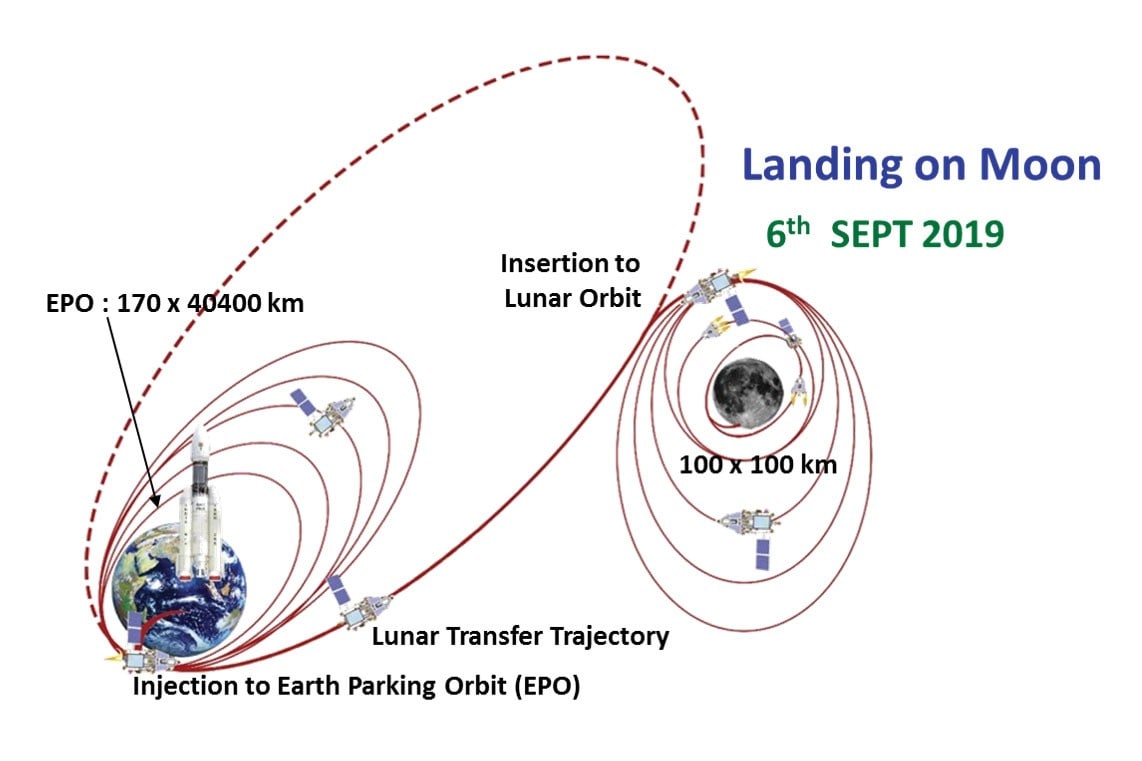The Chandrayaan 2 lunar spacecraft completed a critical manoeuver on its journey to the Moon, the Indian Space Research Organisation confirmed on Wednesday, putting it on a trajectory to reach the Moon’s orbit by 20 August. The manoeuver, known as translunar insertion (TLI) was carried out at 2.21 am on 14 August, as planned, ISRO shared in a tweet. The good news comes several days after the last update we heard from the agency: that the fifth and final Earth-bound orbit-raising of the Chandrayaan 2 spacecraft was completed on 6 August. [caption id=“attachment_7053771” align=“alignnone” width=“1280”] Illustration of the orbit-raising of the Chandrayaan 2 spacecraft in its Earth-bound phase. Image: ISRO[/caption] The Chandrayaan 2 orbiter-lander-rover trio, known collectively as the “composite” will has now been put on a ’lunar transfer trajectory’. This manoeuver placed the spacecraft on a high-orbit that ended in the next stage of the mission: lunar transfer. This week-long phase begins with Chandrayaan 2 breaking away from Earth’s orbit and starting its 3,84,000-kilometre journey to the moon. The last of Chandrayaan 2’s Earth-bound orbits has already brought the spacecraft fairly close to the Moon — a 4,13,623-km orbit around the Earth. In this orbit, as seen in the diagram below, the spacecraft comes fairly close to the Moon at a specific point. [caption id=“attachment_7161011” align=“alignnone” width=“1142”]
 An orbit-raising diagram for Chandrayaan 2. Image: ISRO[/caption] The spacecraft will use its thrusters to come under the moon’s ‘orbit of influence’. Chandrayaan 2 will have to slow itself down just enough using its thrusters to fall into the moon’s reach — gravitationally speaking. This is the main goal of the lunar transfer phase of the mission. (Also read:
**Chandrayaan 2: A step-by-step look at the 47-day journey after its spectacularly successful launch** ) On 22 July, India
launched the country's second moon mission, Chandrayaan 2 , aboard the most powerful rocket in ISRO’s arsenal, the GSLV-MkIII-M1, from the spaceport of Sriharikota in Andhra Pradesh. The mission was primarily aimed at landing a rover in the unexplored lunar south pole. The 3,850-kg, Rs 978-crore spacecraft is a three-module composite made up of an orbiter, lander, and rover. On its planned 48-day journey between liftoff and landing on the Moon’s South Pole, the composite will be subjected to a series of orbital manoeuvres to bring it to the moon’s vicinity.
An orbit-raising diagram for Chandrayaan 2. Image: ISRO[/caption] The spacecraft will use its thrusters to come under the moon’s ‘orbit of influence’. Chandrayaan 2 will have to slow itself down just enough using its thrusters to fall into the moon’s reach — gravitationally speaking. This is the main goal of the lunar transfer phase of the mission. (Also read:
**Chandrayaan 2: A step-by-step look at the 47-day journey after its spectacularly successful launch** ) On 22 July, India
launched the country's second moon mission, Chandrayaan 2 , aboard the most powerful rocket in ISRO’s arsenal, the GSLV-MkIII-M1, from the spaceport of Sriharikota in Andhra Pradesh. The mission was primarily aimed at landing a rover in the unexplored lunar south pole. The 3,850-kg, Rs 978-crore spacecraft is a three-module composite made up of an orbiter, lander, and rover. On its planned 48-day journey between liftoff and landing on the Moon’s South Pole, the composite will be subjected to a series of orbital manoeuvres to bring it to the moon’s vicinity.
As per ISRO’s schedule, the Vikram lander will attempt a soft-landing on the moon on 7 September, and open its hatch for the Pragyan rover to take its first few rolls onto lunar soil four hours later. The landing site of the mission is closer to the South Pole than any mission before it. ISRO has called the mission its most complex and prestigious mission ever. If successful, Chandrayaan 2 will propel India to an elite list of four nations (including Russia, the US and China) that have pulled off a soft-landing on the moon.


)
)
)
)
)
)
)
)
)



